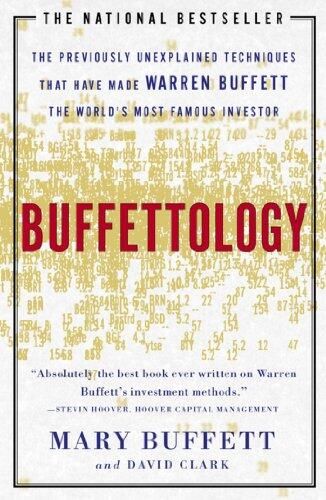Buffettology
Review Buffettology: The Previously Unexplained Techniques That Have Made Warren Buffett The Worlds
by MARY BUFFETT, DAVID CLARK
Description
Warren Buffett is a name in the investment industry that is known by almost everybody. Warren Buffett has been credited for many financial principles and techniques, and with his name came fame and success.
This book illustrates Buffettology or Warren’s ideas like a genius in finance, all compiled in one book that lists all his winning strategies and techniques. The reader will know how to approach investing as Warren does, and more.
This book discusses Buffett’s investment analysis model by cutting through all its complexities and delivering a more reader-friendly approach. Warren’s perspective of finance and investing will surely let the reader look at these two in a new and different light, possibly with more knowledge and insight than before.
The author does a great job of listing Warren’s perspective of finance and his trading methods. Incorporating this into her perspective is also a must to read. Overall, the book offers the gems of a legendary investor, and the author shares this knowledge with her readers.
About the Authors
MARY BUFFETT is an author, speaker, and entrepreneur. She is regarded as among the leading finance experts in America. She has served as a speaker for many esteemed organizations globally. She works with an array of businesses, such as acting as a consultant to Fortune 500 companies.
DAVID CLARK is an expert on Warren Buffett’s philosophies on investing. He graduated with two university degrees, law, and finance. He wrote seven books on finance, especially on Warren Buffett’s investment methods, along with Mary Buffett.
Table of Contents
PART I: THE ART OF BASIC BUFFETTOLOGY
- Before You Begin This Book
- How to Use This Book
- Roots
- Investing from a Business Perspective
- What Is Businesslike Investing?
- Warren’s View of Earnings
- The Price You Pay Determines Your Rate of Return
- The Corporation, Stocks, Bonds—a Few Useful Explanations
- Valuing a Business
- The Only Two Things You Need to Know About Business Perspective Investing: What to Buy—and at What Price
- What We Can Learn from Warren’s Secret Weapon: The Magic of Compounding
- Determining What Kind of Business You Want to Own
- The Theory of an Expanding Intrinsic Value
- The Mediocre Business
- How to Identify the Excellent Business—the Key to Warren’s Good Fortune
- Nine Questions to Help You Determine If a Business Is Truly an Excellent One
- Where to Look for Excellent Businesses
- More Ways to Find a Company You Want to Invest In
- What You Need to Know About the Management of the Company You May Invest In
- When a Downturn in a Company Can be an Investment Opportunity
- How Market Mechanics Whipsaw Stock Prices to Create Buying Opportunities
- Inflation
- Inflation and the Consumer Monopoly
- A Few Words on Taxation
- The Effects of Inflation and Taxation on the Rate of Return, and the Necessity to Obtain a 15% Return on Your Investment
- The Myth of Diversifications Versus the Concentrated Portfolio
- When Should You Sell Your Investments?
- Warren’s Different Kinds of Investments
PART II: ADVANCED BUFFETTOLOGY
- The Analyst’s Role in Ascertaining Earning Power
- The Mathematical Tools
- Test #1, to Determine at a Glance the Predictability of Earnings
- Test #2, to Determine Your Initial Rate of Return
- Test #3, to Determine the Per Share Growth Rate
- Determining the Value of a Company Relative to Government Bonds
- Understanding Warren’s Preference for Companies with High Rates of Return on Equity
- Determining the Projected Annual Compounding Rate of Return, Part I
- Determining the Projected Annual Compounding Rate of Return, Part II
- The Equity/Bond with an Expanding Coupon
- Using the Per Share Earnings Annual Growth Rate to Project a Stock’s Future Value
- How a Company Can Increase Its Shareholders’ Fortunes by Buying Back the Company Stock
- How to Determine If Per Share Earnings Are Increasing Because of Share Repurchases
- How to measure Management’s Ability to Utilize Retained Earnings
- Short-Term Arbitrage Commitments
- Bringing It All Together: The Case Studies
- How Warren Got Started: The Investment Vehicle
- Fifty-four Companies to Look At
- Waiting for the Perfect Pitch
Epilogue
Index
